
September 2007
Volume 11, Number 2
| Contents | | | TESL-EJ Top |
 |
September 2007
|
||
|
Fundamentals of English Grammar: Interactive | ||||
| Title: | Fundamentals of English Grammar: Interactive | 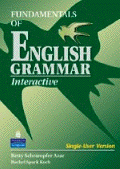 | ||
| Release Date: | February 9, 2007 | |||
| Level: | Intermediate | |||
| Authors: | Azar, Betty Schrampfer and Koch, Rachel Spack | |||
| Publisher: | Pearson Longman | |||
| Product Information: | http://www.longman.com/ae | |||
| Product Type: | CD-Rom Program | |||
| Platform: | Windows | |||
| System Requirements: |
| |||
| ISBNs and Pricing: | Package | ISBN | Price (USD) | |
|---|---|---|---|---|
| CD-ROM
Program 5-pack 10-pack 20-pack Network Version / Site License Installable Version / Site License |
0-13-184414-8 0-13-173389-3 0-13-173388-5 0-13-173387-7 0-13-173384-2 0-13-173385-0 |
$301.27 $1204.00 $2409.33 $4820.00 $7214.67 $7214.67 | ||
Fundamentals of English Grammar: Interactive (FEGi) is a multimedia CD-Rom program designed for those studying grammar at the intermediate level. FEGi provides explanations and examples of a range of grammar points through the use of animated characters, as well as grammar practice through sentence-level and contextualized listening, speaking, and reading exercises. The program is based on the well-known "black book" of the same title from the Azar Grammar Series. The organization of the content in FEGi will be familiar to users of Understanding and Using English Grammar: Interactive, a program reviewed previously in TESL-EJ (Bouziane, 2005). FEGi is intended for use both in independent study or as a complement to classroom instruction.
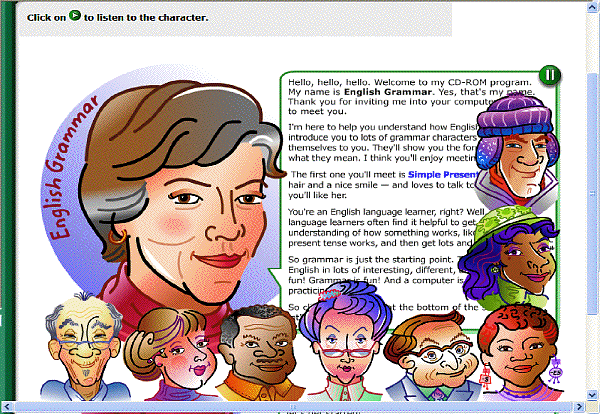
Figure 1. Course Intro Page - "English Grammar" and
some members of her gang of grammar characters
The program content consists of the following:
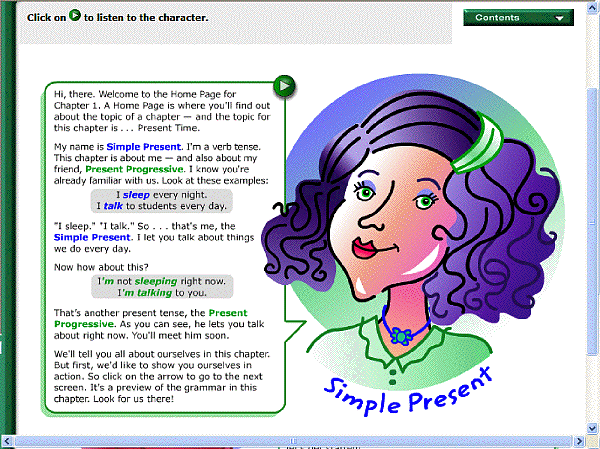
Figure 2. Chapter 1 home page
Each of the chapters of the program is broken down into 8 main parts, as follows:
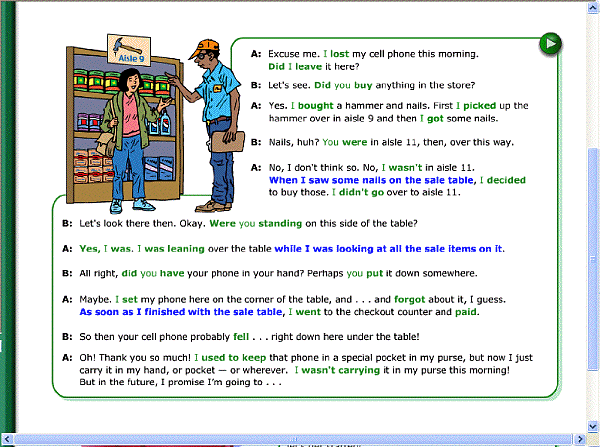
Figure 3. Chapter preview page presenting the simple past in context
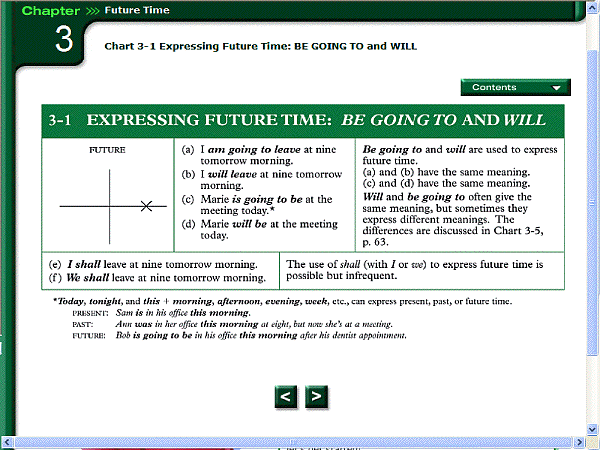
Figure 4. A chart illustrating future time
Additionally, at the top of each page within a chapter are four navigation bars:
Each page also has a Contents navigation bar for moving to any other part of the current chapter (except individual exercises). Exercise pages also have a Charts navigation bar that opens a pop-up window allowing users to review charts for the grammar being practiced.
Like the main chapters, the appendices contain introductions, charts, and exercises. However, they do not have home or preview pages. They also do not have games.
FEGi has much to recommend it for use with English language learners. From a pedagogical standpoint, the "meat" of each main chapter—contextualized presentation of grammar forms and a large number of opportunities to practice them—is, of course, sound. One of FEGi's advantages, though, is that users are not hidebound to the traditional language teaching sequence of "presentation, practice, produce" (PPP). For one thing, the "produce" part of PPP is purposefully absent here—the focus of the program is on practice, and all exercises are, to a greater or lesser degree, examples of controlled practice. More importantly, however, there is no requirement for users of FEGi to go through presentations of grammar before attempting exercises, or, for that matter, to complete exercises on a point of grammar after looking at its presentation. Users are, in fact, free to skip explanations of grammar completely and pursue a more inductive approach to practice by extrapolating from the numerous examples available in the grammar charts, a point well made by Ms. Azar herself in a response (2006) to a review of her and Ms. Koch's earlier Understanding and Using English: Interactive in this journal. To fit personal learning styles, some users may even choose to adopt a "trial and error" approach to the exercises, simply experimenting with grammar knowledge they already have in new and unfamiliar contexts. The program is well suited to this approach, as all of the exercises in FEGi give users at least one chance to change incorrect answers after the first try (see Figure 5).
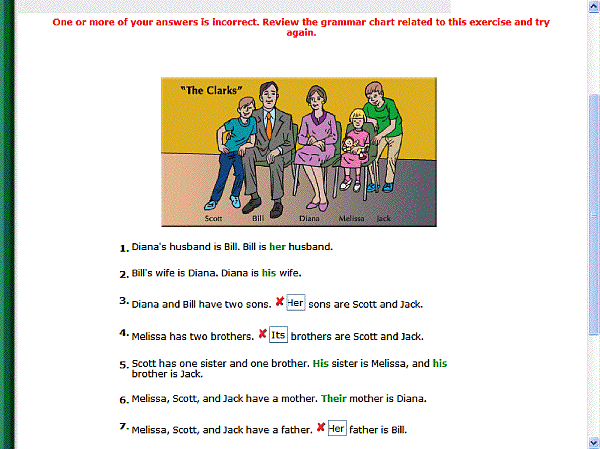
Figure 5. Errors in exercises are noted for self-correction by users
The exercises are, perhaps, the strongest component of the program. The sheer volume and variety of practice opportunities available in FEGi alone are enough to recommend it as a powerful resource. Exercise types include binary or multiple-choice, fill-in-the-blank, editing/error correction, true-false, partial dictation, modified cloze, and others, and exercises incorporate practice with the language skills of reading, listening, and speaking. Speaking exercises requiring users to record responses to listening prompts may be of particular benefit (both perceived and actual) to learners, who can choose to listen to model responses by native speakers before or after providing their own answers, as well as view transcripts of the prompts and model responses in pop-up windows (see Figure 6).
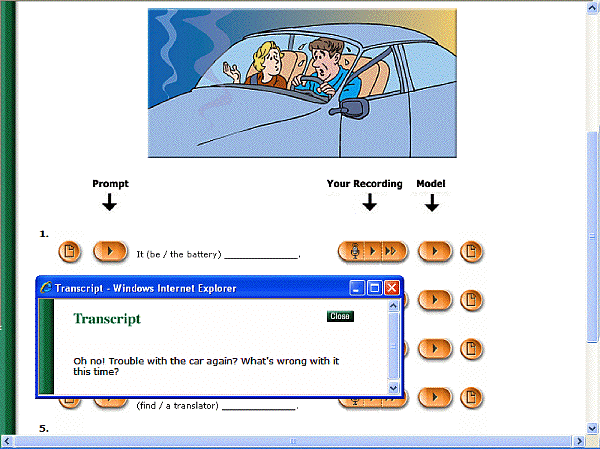
Figure 6. Speaking exercise with pop-up window of audio prompt transcript
Additionally, many of the exercises integrate different skills, such as listening and reading (see Figure 7). A place has also been made in the exercises for possible review and expansion of vocabulary, as certain words, names, and phrases are hyperlinked to FEGi's glossary. Clicking on a hyperlinked item opens a pop-up window displaying a definition and example of the item in use (see Figure 8).

Figure 7. Integrated reading and listening multiple-choice exercise
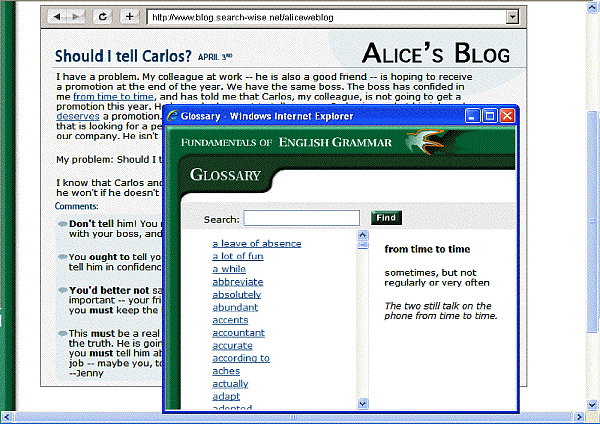
Figure 8. Reading exercise with pop-up window vocabulary definition
It should also be noted that the tests at the end of each chapter (really just more practice opportunities) are quite useful, not only from the standpoint of comprehensive review of chapter grammar, but also for corrective feedback and diagnostic purposes. As can be seen in Figure 9, users can choose to open pop-up windows to see explanations for answers marked as incorrect. Also, upon completing a test, users can view a detailed progress report outlining their achievement with respect to specific points of grammar highlighted in the chapter (see Figure 10). This feature can serve to highlight weak points or gaps in knowledge that may require further coverage by an instructor or review by a learner using the program independently.
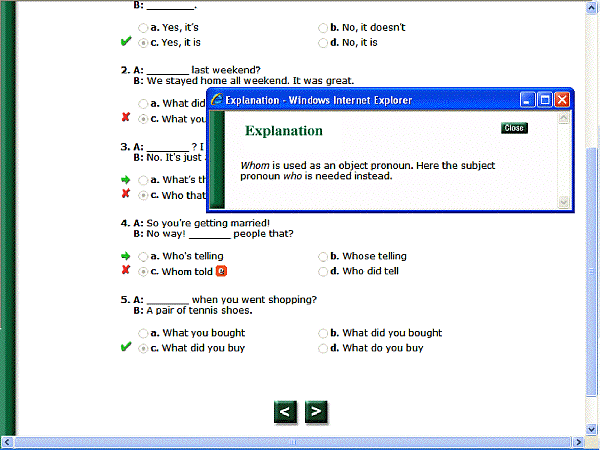
Figure 9. Corrected test items with pop-up window explanation of grammar
Finally, a discussion of the positive points of FEGi would likely be incomplete without mention of the most instantly engaging—and probably most instantly recognizable—feature of the program: the animated grammar characters, or "talking heads." Introduced previously in Understanding and Using English Grammar: Interactive, the talking heads add a high level of entertainment value to the content while simultaneously addressing the pedagogical need of making learners comfortable and encouraging them to have fun with a topic that can be (and is) so often turned into something dry, burdensome, and onerous. It should be said that the author of this review was initially skeptical of using the talking heads with adult learners, expecting to hear demands along the lines of putting aside the animation in order to "get down to business." Instead, both intermediate and advanced students testing the program were quite positive about the characters (though whether they were attracted to the characters' novelty, pure silliness, or high kitsch quotient cannot be stated definitively). Regardless, the talking heads are without question the most unique aspect of FEGi, and the program would be of lesser quality (and interest) without them.
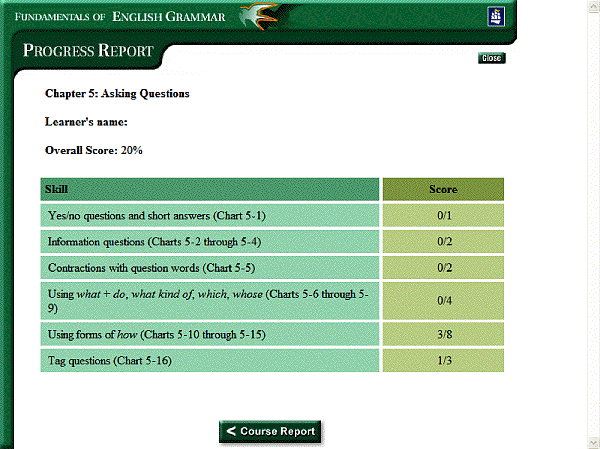
Figure 10. A detailed progress report showing the reviewer's poor grasp
of grammar used in asking questions
When using and evaluating FEGi, questions and ideas for improvement that arise have, actually, little to do with the program's approach to grammar presentation and practice. Such questions and ideas could, however, potentially enhance the effectiveness, user-friendliness, and flexibility of future versions of FEGi.
The first of these questions concerns an issue brought up in the above mentioned review of Understanding and Using English Grammar: Interactive (Bouziane, 2005) and already touched on in the present article, namely that grammar topics seem to be structured in a linear way in the program, and that one topic should or must be covered before moving on to the next. While, again, Ms. Azar has addressed this in her response (2006) to the review, it bears repeating that the content of both the earlier CD-Rom and FEGi have the look of something that must be tackled linearly. FEGi chapters are numbered, after all, and the provision of a table of contents must appear to many instructors and learners habituated to textbook-dictated syllabi (both in ESL and EFL settings) as an implicit direction to begin at the beginning and end at the end. Teaching professionals more comfortable with adapting a textbook or other resource to their own needs will naturally do so with FEGi. Others, however, may not. The most obvious solution to this possible problem is to include a teacher's manual or user's guide as part of the program content, for example as a PDF file accessible from the opening Course Home page.
Next, it is interesting to consider on what basis vocabulary items have been chosen to be hyperlinked within reading passages and exercises and included in FEGi's glossary. Certain words and phrases intuitively seem to be appropriate to the intermediate level for which FEGi is designed (e.g., adapt, rural, slam), while some seem too basic (e.g., back, however, socks), and some seem too infrequent to have much chance of being encountered and reinforced outside of one individual exercise in the program (e.g., agoraphobic, Trinidad and Tobago, whooping cough). This may be a mistaken assumption on the part of the reviewer, but it appears that vocabulary items have been chosen here to fit particular grammatical structures and/or reading passages without consideration of their frequency in actual speech or writing, or close attention to what lexis intermediate learners may need to learn for either practical or academic purposes. With free and easy access to frequency lists based on various corpora (such as those available at the Compleat Lexical Tutor, http://www.lextutor.ca), it would seem readily feasible to identify key vocabulary for a balance of learner settings (ESL and EFL) and purposes (academic and "day-to-day" use), and use this vocabulary to craft reading passages and exercises. Again, it is entirely possible that the authors of FEGi have done this, in which case the reviewer humbly retracts his comments. If the idea has not been previously put into practice, however, its consideration and at least partial adoption might make for an even more powerful instructional resource.
Finally, one of the most critical improvements that could be made to FEGi is to make the program available for the Macintosh operating system. While the newest Macintosh models have the capability of switching between platforms, instructors (such as this reviewer) at institutions with language centers equipped with older Macs may be hampered in their ability to give FEGi-based assignments due to learners' lack of access to computers running Windows. Additionally, such language centers may be unlikely to purchase the program in order to make it available to learners interested in pursuing independent study.
Azar, B. (2006). An author responds. TESL-EJ, 9 (4). Retrieved August 15, 2007, from http://tesl-ej.org/ej36/m0.html.
Bouziane, A. (2005). [Review of the CD-Rom Understanding and Using English Grammar: Interactive]. TESL-EJ, 9 (2). Retrieved August 15, 2007, from http://tesl-ej.org/ej35/m2.html.
|
© Copyright rests with authors. Please cite TESL-EJ appropriately.
Editor's Note: The HTML version contains no page numbers. Please use the PDF version of this article for citations. |